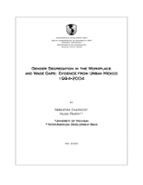Gender Segregation in the Workplace and Wage Gaps: Evidence from Urban Mexico 1994-2004
Date
May 2008
This paper analyzes the evolution of gender segregation in the workplace in Mexico between 1994 and 2004, using a matching comparisons technique to explore the role of individual and family characteristics in determining gender segregation and wage gaps. The results suggest that the complete elimination of hierarchical segregation would reduce the observed gender wage gaps by 5 percentage points, while the elimination of occupational segregation would have increased gender wage gaps by approximately 6 percentage points. The results also indicate that the role of occupational segregation in wage gaps has been increasing in magnitude during the period of analysis, while the role of hierarchical segregation in the determination of wage gaps has been decreasing.



